Types of Martial Arts Uniforms | Everything Explained

You have probably seen a karate kid in a crisp white gi, a Muay Thai fighter in colorful shorts, and a BJJ grappler rolling in pajamas that look like they were made for battle. But here’s the kicker, they are all dressed exactly the way they should be.
Hi, I’m Steve Marlin, a brown belt in Brazilian Jiu-Jitsu, a longtime martial arts nerd, and today, we are diving into a question many beginners often ask:
“Why do martial arts have different uniforms, and what’s the meaning behind each one?”
It’s not just about fashion, believe me! Each of those uniforms, or “gis” and “doboks” as some are called, has a special purpose. They often have a lot of history behind them too.
Think of it like this: a football player needs pads and a helmet, right? Well, martial arts outfits are specific tools for the art. They help us move, train safely, and sometimes even tell us a bit about the art’s origins.
In this article, I’m going to show you some of the main types of martial arts uniforms around the world. We will look at what makes each one unique and why they matter.
What Is a Martial Arts Uniform Called?
When I first walked into a Brazilian Jiu-Jitsu gym, I heard someone yell, “Nice Gi!” I grinned, but secretly thought, “What’s a gi?” If you are new to martial arts, the names for uniforms can feel like a foreign language.
Martial arts uniforms go by different names like gi, dobok, keikogi, or even mawashi, depending on the style. Each name carries history and purpose, tied to the art’s culture and region.
Where Do These Different Names Come From?
Most of these names come straight from the language of the country where the martial art grew up. So, “Gi” and “Keikogi” are Japanese words. “Dobok” is a Korean word. It makes sense, doesn’t it? The name travels with the art.
Overview of Major Martial Arts Uniform Types
| Name of Uniform | Martial Art | Origin Country | Key Features | Common Materials |
| Gi / Karate Gi | Karate | Japan | Lightweight, short sleeves, snap motions, belt (obi) for ranks | Cotton, cotton-polyester blend |
| Judogi (Judo Gi) | Judo | Japan | Heavyweight, reinforced stitching, thick collar for grips | Heavy cotton, double weave |
| BJJ Gi | Brazilian Jiu-Jitsu | Brazil (via Japan) | Tighter fit, reinforced collar, often decorative with patches | Cotton, pearl weave, gold weave |
| Dobok | Taekwondo | Korea | V-neck or crossover design, light fabric, school/rank trims | Polyester, cotton blend |
| Kendogi + Hakama | Kendo | Japan | Worn with Hakama pants, paired with armor (bogu), a traditional look | Cotton, indigo-dyed fabric |
| Aikido Gi + Hakama | Aikido | Japan | Similar to the Judo Gi, Hakama worn by advanced students, wide-leg design | Cotton, canvas |
| Muay Thai Shorts | Muay Thai | Thailand | Short cut, satin shine, elastic waistband, often flashy design | Satin, microfiber, polyester |
| Rash Guard + Shorts | MMA Uniform | Global (Modern) | Tight fit, moisture-wicking, allows flexibility, and grappling | Lycra, spandex, polyester |
| Boxing Trunks + Tank Top | Boxing | USA / UK (Modern) | Loose shorts, sleeveless top, worn with gloves and protective gear | Nylon, polyester, satin |
Traditional Martial Arts Uniforms by Discipline
Karate: The Karategi

The traditional uniform for karate is called a Karate Gi. It’s a crisp, white outfit with a jacket, pants, and belt. I remember watching karate students in my gym, their gis snapping with every punch.
The karategi is light, letting you move fast for strikes and blocks. It’s cotton fabric breathes well, keeping you cool during practice.
The belt shows your rank: white for beginners, black for masters. A cool fact? The white color stands for purity and focus in Japanese culture. If you are starting karate, get a karategi that fits loosely for easy kicks.
Judo: The Judogi

Judo’s uniform, the Judo Gi, is a tough, white outfit built for grappling. It’s heavier than a karategi, with a thick jacket, pants, and belt.
My judo friend once showed me how the judogi’s sturdy collar lets you grab and throw without tearing. In competitions, you might see blue judogi to tell players apart.
The thick cotton stands up to tugs and pulls. Like karate, the belt shows your rank, tying you to judo’s Japanese roots. Starting judo? Pick a judogi with strong stitching for those intense throws.
Pro Tip: Try a single-weave judogi for lighter training or a double-weave for competitions.
Brazilian Jiu-Jitsu: The BJJ Gi

As a BJJ brown belt, I can tell you that BJJ Gi is my second skin. It’s a tight-fitting jacket, pants, and belt, usually white, blue, or black.
The GI’s tough cotton or ripstop fabric handles rough grappling, trust me, I have tested it in countless rolls! Its sleeves and collar give you grips for controlling your opponent, like in guard or mount.
The belt shows your rank, from white to black. In BJJ, the gi must follow rules for tournaments, like IBJJF standards. New to BJJ? Get a gi that’s snug but not tight for easy moves.
Pro Tip: Check out the BJJ gi guide to find one that meets tournament rules.
Taekwondo: The Dobok

Taekwondo’s uniform, the dobok, is a light, white outfit with a V-neck jacket, pants, and belt. I tried taekwondo once, and the dobok felt like wearing clouds, perfect for high kicks! It’s a cotton or polyester blend that lets you spin and strike with ease.
The V-neck sets it apart from other uniforms, and the belt shows your rank, just like in karate. Born in South Korea, the dobok reflects speed and precision. If you are starting taekwondo, choose a dobok that’s loose for flexibility.
Pro Tip: Look for a dobok with stretchy fabric if you love those flashy kicks.
Kendo: The Kendogi and Bogu

Kendo uniforms look completely different from other martial arts clothes. They have two main parts: the Kendo Gi (jacket) and the hakama (pleated trousers).
The kendogi is usually navy blue or white with shorter sleeves than a karategi. What’s really unique is the hakama – those wide, pleated trousers that almost look like a skirt. They have seven pleats (five in front, two in back) that symbolize the virtues of bushido.
On top of this, kendoka wear protective armor called bogu, which includes a helmet with metal bars (men), chest protector (do), waist protector (tare), and gloves (kote).
When I watched a kendo class, I was struck by how the uniform created a distinct silhouette, especially when practitioners moved quickly during strikes.
Pro Tip: Adjust your bogu straps tightly to stay safe during sparring.
Aikido: The Aikidogi and Hakama

Aikido practitioners wear a uniform similar to judogi but with some differences. The jacket may have shorter sleeves to prevent tangling during wrist techniques.
What sets aikido apart is that senior students also wear the hakama (pleated trousers), similar to kendo. In many schools, you earn the right to wear the hakama when you reach the black belt.
The hakama in aikido helps hide foot movements, making it harder for opponents to predict your next move. It also creates that distinctive flowing appearance during the circular movements aikido is known for.
My aikido friend says the swishing sound of the hakama during practice becomes almost meditative after a while.
Pro Tip: Practice tying your hakama, it’s tricky but worth it for the cool factor!
Modern/Hybrid Martial Arts Uniforms
Muay Thai: Muay Thai Shorts

Muay Thai’s uniform is all about Muay Thai shorts. When I first stepped into a Muay Thai gym, I was surprised, no jacket, no belt, just shorts. And that’s exactly the point.
- Top: Usually shirtless for men, or a sports top for women.
- Bottom: Muay Thai shorts, lightweight, satin or nylon, with wide legs for high kicks and knee strikes.
Muay Thai fighters wear shorts and sometimes tops that allow for maximum movement. The shorts come in bright colors with fancy designs that catch the eye.
These shorts are shorter than what you would see in other martial arts. Why? The design helps fighters kick without anything getting in the way.
Most Muay Thai shorts feature wide leg openings and a high cut that makes high kicks easier. The fabric is light and quick-drying, perfect for the fast-paced nature of this Thai boxing style.
MMA: MMA Gear
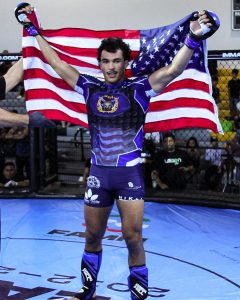
Mixed Martial Arts (MMA) uses MMA gear, a combo of a rash guard and fight shorts or leggings. This outfit is tight and stretchy, perfect for grappling and striking.
I have rolled with MMA fighters, and their gear never gets caught like my BJJ gi does! Made of polyester or spandex, it wicks sweat and moves with you.
Many fighters add sponsor logos for a pro look. New to MMA? Get gear that’s snug to avoid snags in the cage.
No-Gi BJJ: No-Gi Uniforms
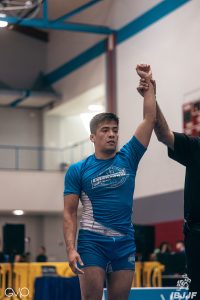
In No-Gi Brazilian Jiu-Jitsu, you swap the gi for a no-gi uniform, typically a rash guard and shorts or spats.
As a BJJ brown belt, I love the freedom of no-gi; my rash guard feels like a second skin! The tight polyester or spandex stops opponents from grabbing loose fabric.
It’s great for grappling without the gi’s grips. Starting no-gi BJJ? Choose a rash guard that fits like a glove for smooth rolls.
Boxing Attire

Boxing keeps it simple with shorts, shoes, and sometimes a sleeveless top. The shorts are often made with satin for that classic shine under the lights.
Boxing trunks sit higher on the waist than other martial arts shorts. This design allows full hip rotation for powerful punches.
The shoes are just as important as the shorts. Boxing shoes are light, have good ankle support, and grip the canvas floor to help with footwork.
Region-Specific or Lesser-Known Uniforms
Kung Fu/Wushu Uniform
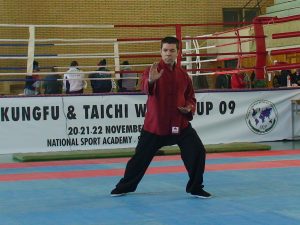
The attire for Chinese martial arts, broadly categorized as Kung Fu or Wushu, varies significantly depending on the specific style, region, and whether it’s for traditional practice or modern sport Wushu.
- Traditional Kung Fu Uniforms: Often consist of loose-fitting pants and a top with frog-button closures (often a mandarin collar). The fabric is typically cotton or silk, allowing for a wide range of motion necessary for dynamic kicks, stances, and intricate hand movements. Colors can vary widely, from traditional blacks and whites to more vibrant hues. Some styles might incorporate a sash around the waist.
- Wushu Uniforms (Modern Sport): These are often more fitted and streamlined than traditional uniforms, made from lighter, synthetic materials for acrobatic movements and speed. They are typically brightly colored, highly stylized, and sometimes feature intricate embroidery or patterns, especially for performance competitions.
Capoeira
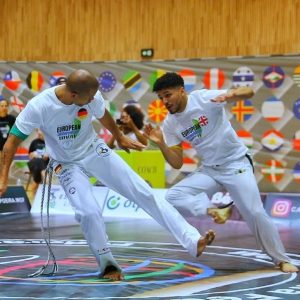
The uniform for Capoeira, the Afro-Brazilian martial art that combines elements of dance, acrobatics, and music, is designed for fluidity and freedom of movement during its unique acrobatic and rhythmic exchanges.
- Abadá: These are loose-fitting, white cotton pants that are the hallmark of Capoeira attire. The white color is symbolic of purity and peace. The loose fit allows for the wide, sweeping kicks, spins, and acrobatic movements characteristic of Capoeira.
- White T-shirt or no shirt: Practitioners typically wear a simple white T-shirt or, especially for men, go shirtless during training and roda (Capoeira circle) performances.
- Corda (Belt): A colored rope worn around the waist, signifying the practitioner’s rank.
Krav Maga

Krav Maga, the self-defense system developed for the Israel Defense Forces, prioritizes practicality and real-world application. Its “uniform” reflects this no-frills philosophy.
- T-shirt: Typically a plain, often black or white, t-shirt with the Krav Maga logo. The focus is on comfort and unrestricted movement.
- Tactical Pants or Cargo Pants: Durable, comfortable pants that allow for full range of motion. Jeans or athletic pants are also common. The emphasis is on wearing clothing that one might wear in a real-life situation.
- Athletic Shoes: Any comfortable and supportive athletic footwear is suitable.
- Protective Gear: Given its focus on realistic self-defense, groin protectors, mouthguards, and sometimes shin guards or headgear are essential during training.
Silat Uniform

Silat, a collective term for a class of indigenous martial arts from the Malay Archipelago, features diverse styles with varying attire, but some common elements exist.
- Baju Silat (Silat Shirt): This is typically a loose-fitting, long-sleeved top that allows for a full range of arm movements for strikes, blocks, and joint locks.
- Seluar Silat (Silat Pants): These are loose-fitting trousers with a wide crotch, designed to accommodate the deep stances, sweeps, and dynamic leg movements common in Silat.
- Kain Samping/Sarong: In some traditional styles, a sarong or a shorter wrapped fabric (kain samping) may be worn over the pants for cultural significance or to provide additional movement.
- Colors: While black is common, colors can vary by style, region, or school.
Sambo Kurtka
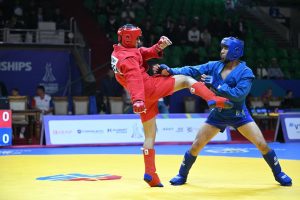
Sambo, a Russian martial art and combat sport, combines elements of Judo, wrestling, and other combat systems. Its uniform is specifically designed for grappling.
- Kurtka (Jacket): The defining feature of the Sambo uniform is the Kurtka, a sturdy jacket similar to a judogi but with some key differences. It has straps for the belt and sleeves that are shorter and wider, making it harder for opponents to grip. It often features small “wings” or loops under the arms for gripping. Kurtkas are typically blue or red for competition.
- Shorts: Sambo practitioners wear shorts (often matching the color of the kurtka, blue or red) rather than pants, allowing for greater leg mobility and preventing an opponent from gripping the legs.
- Sambovki (Shoes): Soft, padded shoes with a suede sole, designed for grip and preventing mat burn on the feet while allowing for foot locks.
Hapkido Uniform
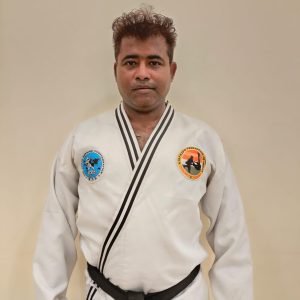
Hapkido, a Korean martial art known for its wide range of techniques, including strikes, joint locks, throws, and weapons defense, utilizes a uniform similar to Taekwondo’s Dobok, but often with slight variations.
- Dobok (Korean Uniform): Like Taekwondo, Hapkido practitioners wear a Dobok, typically white. It consists of a jacket and pants.
- Jacket Design: While some Hapkido doboks feature the V-neck pullover style common in WT Taekwondo, many traditional Hapkido schools use an open-front jacket that ties, similar to a traditional karate gi or ITF Taekwondo dobok. This allows for easier removal if a joint lock is applied to the gi itself.
- Black Trim/Collars: As with Taekwondo, some Hapkido organizations may use black trim on the collar or have black doboks for advanced practitioners or masters.
HEMA (Historical European Martial Arts)
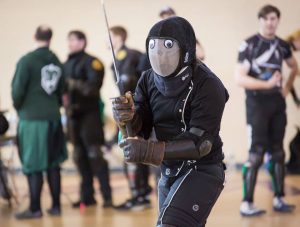
HEMA is a relatively modern practice focused on the reconstruction and revival of historical European fighting systems based on surviving treatises and manuals. As such, there isn’t one single “uniform,” but rather practical attire focused on safety and movement during practice with replica weapons.
- Fencing Jacket/Gambeson: Heavily padded jackets (often synthetic for modern HEMA, sometimes cotton) designed to absorb impacts from blunt training weapons. They can vary in thickness and style based on the weapon system being practiced.
- Fencing Pants/Breeches: Durable, often padded pants designed to protect the legs and allow for lunges and footwork.
- Gloves: Heavily padded gloves, often resembling gauntlets, are crucial for hand protection due to the use of steel or synthetic weapons.
- Mask: A specialized fencing mask with a mesh front is essential for head and face protection.
- Gorget: Neck protection worn under the mask.
- Protective Gear: Additional padding for elbows, knees, shins, and groin is common, depending on the weapon system and intensity of sparring.
- Normal Athletic Wear: For less intense drills or conditioning, practitioners might simply wear athletic shirts and pants.
Martial Arts Uniform Comparison
What Is The Difference Between a Dobok And a Gi?
A dobok is the uniform for taekwondo, with a V-neck jacket designed for high kicks, while a gi is used in arts like Brazilian Jiu-Jitsu and karate, built for grappling or striking.
| Feature | Dobok | Gi |
| Origin | Korea | Japan |
| Top Style | V-neck pullover | Wrap-around jacket |
| Material | Lightweight polyester or cotton blend | Heavy cotton weave with reinforced stitching |
| Fit | Loose for high kicks | Snugger cut to limit excess fabric during grabs |
| Purpose | Striking arts (kicks, blocks) | Grappling arts (throws, holds, ground work) |
| Belt Tie | Square knot beneath V-neck | Wrapped around the waist and tied in front |
Is There A Difference Between A BJJ Gi And A Judo Gi?
Yes. A BJJ gi is cut closer to the body and made for ground work and faster movement. A Judo gi is heavier, with extra stitching and a stiffer collar for safe throws and grips.
| Feature | BJJ Gi | Judo Gi |
| Origin | Brazil (from Japanese roots) | Japan |
| Fabric Weight | Medium–light (350–550 gsm) | Heavy (550–750 gsm) |
| Weave Type | Pearl or gold weave | Single or double weave |
| Fit | Slim cut, shorter jacket and sleeves | Roomy cut, longer jacket and sleeves |
| Collar | Softer, thinner collar for faster chokes | Thick, stiff collar to withstand grab pressure |
| Pant Design | Tapered legs, elastic and drawstring waist | Straight legs, reinforced knees, drawstring waist |
| Color Options | White, blue, black, plus team or school patches | Mainly white and blue, limited to approved colors |
| Competition Rules | IBJJF allows various colors and branding | IJF restricts color and patch placement |
| Primary Use | Ground fighting, submissions, guard work | Throwing, standing grappling, breakfalls |
What Is The Difference Between A BJJ gi And A Karate Gi?
A BJJ gi is thicker and snugger, built for grappling and gripping, while a karate gi is lighter and looser, made for striking and fast moves. I have worn both, and trust me, they feel like different worlds!
| Feature | BJJ Gi | Karate Gi |
| Fabric Weight | Heavy (350–650 gsm) | Light to medium (200–350 gsm) |
| Weave Type | Pearl or gold weave | Single or lightweight plain weave |
| Fit | Trimmed cut, shorter jacket and sleeves | Roomy cut, longer sleeves and pants |
| Collar | Thick, stiff collar for choke defense | Thin, flexible collar for easy movement |
| Sleeves | Tapered to limit extra fabric for grip | Wide sleeves for a full range of motion |
| Pants | Tapered with a drawstring and reinforced knees | Straight-leg, elastic/drawstring waist |
| Color Options | White, blue, black, plus school patches | Mostly white; sometimes colored by style |
| Purpose | Grappling, ground control, submissions | Striking, kata practice, and sparring |
| Care Tips | Wash cold, avoid bleach to keep fabric strong | Wash warm, gentle cycle to keep the shape |
What Is The Difference Between a Karate Gi And a Taekwondo Gi?
The primary difference between a Karate gi and a Taekwondo dobok lies in their design and cut, optimized for the distinctive movements of each art. A Karate gi often features an open, crossover jacket for powerful, linear strikes, while a Taekwondo dobok frequently uses a V-neck pullover design for unhindered, dynamic kicking techniques.
| Feature | Karate Gi | Taekwondo Dobok |
| Origin | Japan | Korea |
| Top Style | Wrap-around jacket tied with a belt | V-neck pullover |
| Neckline | Crossover collar | V-shaped collar |
| Fabric Weight | Medium to heavy (250–350 gsm) | Light to medium (150–250 gsm) |
| Cut | Roomy sleeves and trousers for wide stances | Slimmer arms and legs for quick kicks and splits |
| Pants | Straight-leg with drawstring or elastic waist | Slim-cut with elastic waist and drawstring |
| Belt Style | Wrapped around the waist, tied in front | Wrapped under the collar, tied in front |
| Purpose | Punches, blocks, kata, and stable footing | High kicks, fast footwork, and dynamic sparring |
| Common Colors | Mostly white; sometimes black or colored trim | Mostly white; black trim for masters or patterns |
What Are The Differences Between A Karate Gi And A Judo Gi?
Their fundamental differences stem from the distinct nature of their respective arts. A Judo gi is built to withstand constant gripping and the stresses of throwing and grappling, making it much heavier and more reinforced, whereas a Karate gi is designed for freedom of movement during striking, kicking, and kata, and is therefore lighter.
| Feature | Karate Gi | Judo Gi |
| Origin | Japan | Japan |
| Fabric Weight | Light to medium (200–300 gsm) | Heavy (550–750 gsm) |
| Weave Type | Plain or single weave | Single or double weave |
| Fit | Roomy cut for broad stances and quick moves | Roomier cut but longer sleeves and jacket |
| Collar | Thin, flexible collar for easy turns | Thick, stiff collar to resist strong grips |
| Sleeves | Wide sleeves ending at mid-forearm | Longer sleeves to protect against sleeve pulls |
| Pants | Straight legs, elastic or drawstring waist | Reinforced knees, drawstring waist |
| Durability | Made for light wear, easy washing | Built to resist tearing during throws and holds |
| Purpose | Striking, blocking, kata | Throwing, standing, grappling, breakfalls |
Common FAQs on Martial Arts Uniforms
Can You Use A BJJ Gi For Judo Or Vice Versa?
You can, but it’s not ideal. A BJJ gi is tighter and made for ground grappling, while a Judo gi is bulkier and built to withstand strong throws. If you wear a BJJ gi in a Judo class, expect it to get torn up faster than a white belt at open mat.
Why Are Martial Arts Uniforms White?
White symbolizes purity, discipline, and a beginner’s mind, kind of like saying, “Hey, I’m here to learn, not to flex.” It also makes it easier for instructors to spot technique, posture, and yes… sweat stains.
What Is A Martial Arts Belt System?
The belt system shows your rank and progress in martial arts. You usually start with white (beginner) and work your way up to black (advanced), but the colors and meanings vary by style. In BJJ, for example, we don’t hand out belts like Halloween candy; you earn them with grit and mat time.
Are Martial Arts Uniforms Unisex?
Yes, most traditional martial arts like Karate, Judo, Taekwondo, and BJJ, the uniforms (gi or dobok) are designed to be unisex. Their loose-fitting nature accommodates various body types for both male and female practitioners.
While sizing is based on height and weight, some individuals may choose to wear additional modesty undergarments. The cut fundamentally prioritizes freedom of movement over gender-specific tailoring.
How To Care For And Wash Your Martial Arts Uniform?
Proper care extends your uniform’s life and maintains hygiene. Always wash it immediately after training using cold water and a mild detergent to prevent shrinking, fading, and odor. Avoid fabric softeners as they can degrade fibers.
For best results, hang dry to prevent shrinking and preserve fabric integrity. If using a dryer, opt for a low-heat setting. Wash new colored uniforms separately to prevent dye transfer.
Can You Train In Martial Arts Without A Uniform?
Some styles like MMA, No-Gi BJJ, or Krav Maga allow training without a traditional uniform. But for most traditional martial arts, the uniform is part of the discipline. It’s not just clothing, it’s the mindset.
What Are The Different Styles Of The Gi?
The “gi” encompasses various styles, each tailored to a specific Japanese or Brazilian martial art. The Karate gi is lighter and looser for striking.
The Judo gi is exceptionally heavy and reinforced, particularly the collar, for rigorous gripping and throwing.
The BJJ gi, derived from Judo, is also robust but typically more fitted with a stiffer, thicker collar for ground grappling. Aikido and Kendo also use specific gi designs, often paired with a hakama.
What Do Martial Arts Students Wear?
Martial arts students wear specific uniforms tailored to their discipline. For traditional Japanese and Korean arts (Karate, Judo, Taekwondo, BJJ, Aikido, Hapkido), they wear a gi or dobok, consisting of a jacket, pants, and a colored belt signifying rank.
In modern or hybrid arts like Muay Thai, MMA, or No-Gi BJJ, students wear specialized athletic attire such as fight shorts, rashguards, or basic t-shirts and athletic pants, prioritizing unrestricted movement for striking and grappling.
What Are The Three Types Of Taekwondo Uniforms?
Taekwondo uniforms, called doboks, come in three main types. While there isn’t a universally recognized classification of “three types” of Taekwondo uniforms, variations generally stem from:
- WT (World Taekwondo) Style Dobok: Characterized by a V-neck pullover jacket, often without lapels, designed for sport Taekwondo. The fabric is typically lighter for ease of movement and comfort during dynamic kicking.
- ITF (International Taekwon-Do Federation) Style Dobok: Features a traditional open-front jacket that ties, similar to a karate gi, often with a white or black trim depending on rank and organization. The fabric might be slightly heavier.
- Traditional/Demonstration Dobok: These usually vary more widely in design, sometimes incorporating more traditional Korean elements, specific embroidery, or heavier fabrics for demonstrations or forms practice, where durability and a sharp appearance are prioritized.
What Are The Levels Of Taekwondo Uniforms?
Taekwondo uniforms don’t have strict “levels,” but they change with rank. Beginners wear a plain white dobok with a white belt. As you advance, you might get a dobok with black trim, especially for black belts.
Some schools use colored doboks (like blue or red) for special teams or instructors. Your belt shows your level, not the dobok itself. Pick a comfy dobok to kick with confidence!
What is Better WTF or ITF Taekwondo?
This one’s like asking, “Which is better, pizza or tacos?” It depends on what you like.
- WTF (now WT) is more sport-based, with full-contact sparring and Olympic-style rules.
- ITF is more traditional, focusing on patterns (called “tuls”), self-defense, and semi-contact sparring.
Both styles are legit. If you love competition and kicking pads at lightning speed, WT might be your thing. If you want a mix of history, structure, and practical techniques, ITF is worth exploring.
What Is A Taekwondo Uniform Called?
A taekwondo uniform is called a “dobok.” This Korean word combines “do” (way or path) and “bok” (clothing), meaning “clothing of the way.”
Using the correct term shows respect for the Korean origins of the art.
What Are Jiu-Jitsu Uniforms Called?
In Brazilian Jiu-Jitsu, we call our uniforms “gi” (pronounced “ghee”). Sometimes people also call them “kimonos,” though this isn’t technically correct since kimono refers to traditional Japanese clothing.
For Japanese Jiu-Jitsu, they also use “gi” or more formally “jujutsugi.” No-gi training outfits are simply called rashguards and shorts.
What Is A Judo Uniform Called?
A judo uniform is called a “judogi.” This combines “judo” with “gi” (clothing). Sometimes people simply call it a “gi” for short.
The judogi consists of a heavy jacket (uwagi), pants (shitabaki), and belt (obi). Judo
What Are The Four Styles Of Karate?
Karate has four main traditional styles: Shotokan, Goju-Ryu, Shito-Ryu, and Wado-Ryu. Shotokan focuses on powerful strikes and deep stances. Goju-Ryu blends hard and soft techniques. Shito-Ryu emphasizes forms and precision. Wado-Ryu mixes karate with jujitsu for fluid moves. Each style uses a white karategi, but techniques differ.
What Does Dobok Mean In Korean?
In Korean, Dobok (도복) literally translates to “clothing of the way” or “training uniform.” “Do” (도) means “way” or “path,” and “bok” (복) means “clothing” or “uniform.”
Do You Wear Clothes Under A Dobok?
Yes! You should always wear underwear and usually a t-shirt under your dobok.
Men typically wear shorts or compression shorts under the pants and often a t-shirt (sometimes matching their belt color) under the jacket. Women generally wear sports bras and t-shirts under the jacket and appropriate underwear beneath the pants.
This is both for hygiene and modesty, as doboks can sometimes open during practice.
Who Can Wear A Black Dobok?
In many schools, a black dobok is reserved for black belts or instructors. It’s a sign of rank, experience, and leadership.
But not all schools follow this. Some let anyone wear a black uniform, while others stick to white for everyone. When in doubt, ask your instructor, it’s like asking dress code at a formal party.
Do MMA Fighters Wear Uniforms?
Yes, they do, but not in the traditional sense. MMA fighters don’t wear gis or doboks. Instead, they wear performance-based gear designed for both striking and grappling. Typically, an MMA fighter’s uniform includes:
- MMA shorts (no pockets or zippers, built for flexibility and safety)
- Rashguard (optional, but common in training and certain promotions)
- MMA gloves, mouth guard, and sometimes shin guards (in training)
While each promotion (like UFC, Bellator, ONE Championship) may have slight variations or sponsor-branded gear, the goal is always the same: maximize movement, comfort, and safety during a high-paced, full-contact fight.
What Are Combat Uniforms Called?
Combat uniforms go by different names depending on the martial art. In MMA, they are called MMA gear, usually a rash guard and shorts.
For Brazilian Jiu-Jitsu, it’s a gi for traditional classes or no-gi gear (rash guard and shorts) for modern ones.
Taekwondo uses a dobok, judo has a judogi, and karate rocks a karate gi. Muay Thai fighters wear shorts, and boxers have boxing attire (shorts and a tank top).
Each name ties to the sport’s culture and purpose, like how my BJJ gi helps me grip during rolls.
Conclusion: Find Your Perfect Martial Arts Uniform
From crisp karate gis to flashy Muay Thai shorts, every martial arts uniform tells a story of culture and purpose. Whether you’re kicking in taekwondo or grappling in BJJ, the right gear boosts your confidence and performance.
As a BJJ brown belt, I’ve learned that a uniform is more than clothes; it’s your badge of dedication.
 Martial Boss
Martial Boss